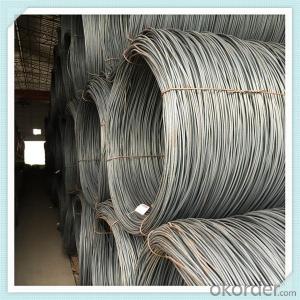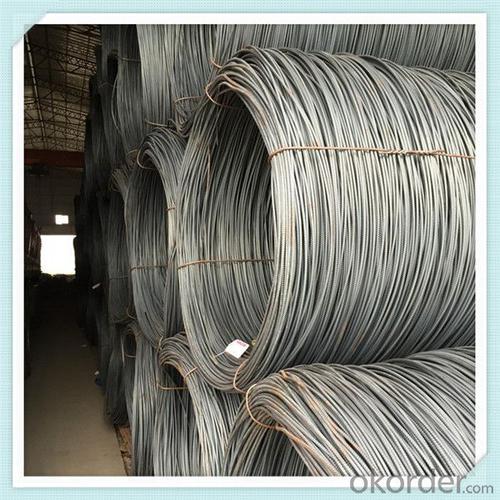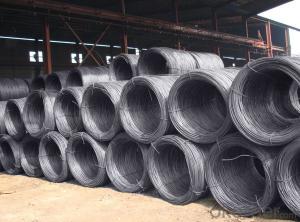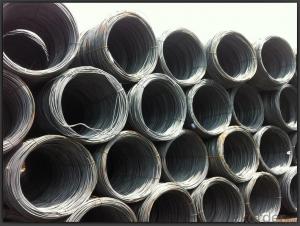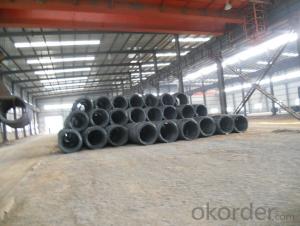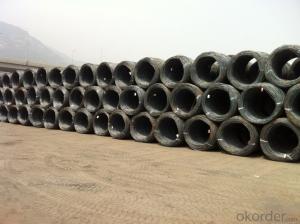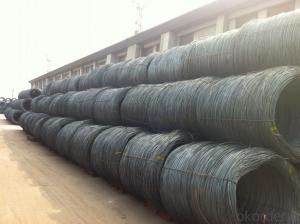Hot rolled steel wire rod SAE1008-SAE1018
- Loading Port:
- Qingdao
- Payment Terms:
- TT OR LC
- Min Order Qty:
- 100 m.t.
- Supply Capability:
- 15431 m.t./month
OKorder Service Pledge
OKorder Financial Service
You Might Also Like
Specification
Features
1、Pure steel quality, stable chemical contents, small tolerance.
2、Constant Quality, good drawing performance.
3、High dimension accuracy degree, accuracy degree of Level C up to 80%, smooth surface, less scale,
easy to be pickled.
4、Automatic bundling with 4 lines by Machine in tidy and good looks
5、Big high quality percentage, small coil percentage, and heavy coil weight for Hard Coil.
6、High sorbitizing percentage.
Our Advantage: High quality steel products from 1 class mills in
Reasonable price
Professionalism of the products
On-time delivery
Complete documents and certificates
Sincere service to meet our clients' requirements
Product Description :
Standard | AISI, ASTM, BS, DIN, GB, JIS |
Material/steel grade | Q195-Q235,SAE1006B,SAE1006CR, SAE1008B, SAE1008CR, SAE1010B, SAE1018B, or according to customers requirements |
Wire Gauge | 5.5-12mm |
Coil weight | 1.8-2.1mts |
MOQ | 25MT |
Delivery Time | 15-30 days after receipt of L/C or deposit by T/T |
Packing | In coil and load in container, if large quantity, by bulk vessel; Can be packed as customers' special requirements |
Payment terms | 1).100% irrevocable L/C at sight. 2).30% T/T prepaid and the balance against the copy of B/L. 3).30% T/T prepaid and the balance against L/C |
Application | widely used in machinery parts, manufacturing industry, electronics industry, metal tools and others |
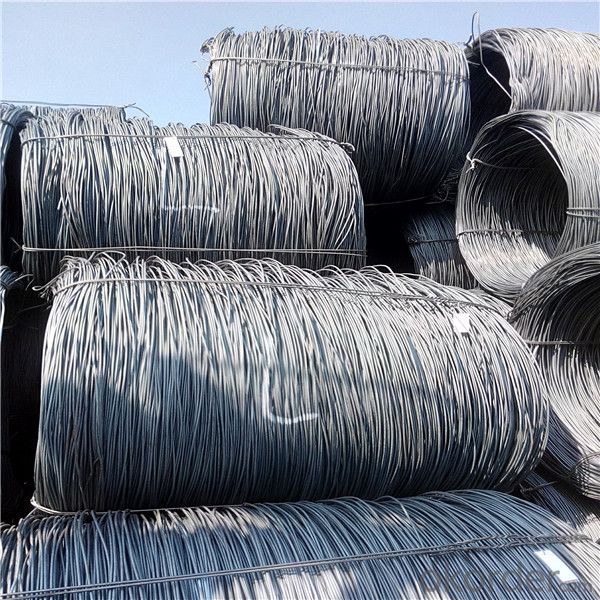

Application :
It generally used in braiding the hose for bathing product and machinery. With it
good flexibility, resistant to high temperature and resistant to corrosion, it
used widely in many industries.
Packing :
Hot-rolled wire rod is held in a unit with at least four steel straps in the
transverse direction and transported and stored without further packaging.
Before
the steel strapping is applied, the wire rod must be sufficiently compressed.
The strapping is fixed in the transverse direction with a single circumferential
strap so that the strapping does not slip and cause the coil to come apart.


Our service:
(1) We cooperate with famous factories with advanced equipment and well trained workers.
(2) We can provide factory price with trading company service.
(3) We continuously work on the improvement of our processes, guaranteeing
consistently high standards of quality to keep none compensation.
(4) We guarantee 24 hours response and 48 hours solution providing service.
(5) We accept small order quantity before formal cooperation.
(6) We deliver the agreed quality at the agreed time, reacting to changes in
customer wishes in a flexible way.
(7) Due to our volume and selling power, we have excellent freight rates with
shipping lines.
(8) We strive to always be fair and honest in our dealings with customers.
(9) We strive to work together with customers to achieve much more than we can
achieve alone.
(10) Through our passion and commitment we aim to be a market leader in all our
key markets. To maintain our position as market leader we must continue to add
value in all that we do.
FAQ:
1.Q: What's your MOQ(minimum order quantity)?
A: One full container, mixed acceptable .
2. Q: What's your packing methods?
A: Packed in bundle or bulk ..
3. Q: How can I buy CNBM products in my country?
A:Please send us an inquiry or email ,we will reply to you if there is distributor in your country
4. Q: Can we visit your factory?
A: Warmly welcome. Once we have your schedule, we will arrange the
professional sales team to follow up your case.
5. Q: How long does it take to get the product if i place an order?
A:With the process of your requirements,we will pack and deliver in 3
-7 days. If it is by sea shipment,it will take 15-45 days depending on different locations
- Q: What are the different tolerances for steel wire rods?
- The tolerances of steel wire rods can differ based on their specific application and industry standards. However, there are generally accepted tolerance ranges for different dimensions of steel wire rods. One common tolerance pertains to the diameter or thickness of the wire rod, which can vary from a few millimeters to several inches depending on its intended use. For example, wire rods used in construction for reinforcing concrete may have a tolerance of +/- 0.5 mm, while those used in manufacturing automotive components may have a tighter tolerance of +/- 0.1 mm. Another crucial tolerance to consider is the straightness of the wire rod, referring to its overall straightness along the entire length. Straightness tolerances can range from a few millimeters to a few centimeters per meter. For applications requiring precise alignment, such as in the production of precision instruments or machinery, tighter straightness tolerances are necessary. Surface finish is also significant and can have specific tolerances for steel wire rods. This refers to the condition of the surface, including any imperfections or irregularities. Depending on the intended use, surface finish tolerances can range from rough, measuring a few micrometers, to smooth, resembling a mirror-like finish. It's important to note that these tolerance ranges may slightly vary depending on the specific standards set by different organizations or countries. For instance, the American Society for Testing and Materials (ASTM) has its own set of tolerances for steel wire rods, and the International Organization for Standardization (ISO) has its own standards as well. In conclusion, the tolerances for steel wire rods can differ based on factors like diameter, straightness, and surface finish. These tolerances are necessary to ensure that the wire rods meet the required specifications and perform effectively in their intended applications.
- Q: What are the major barriers to entry in the steel wire rod market?
- Several factors contribute to the major obstacles faced by potential new entrants in the steel wire rod market. First and foremost, the substantial capital investment required presents a significant barrier. To establish a steel wire rod production facility, considerable funds must be allocated towards machinery, equipment, and infrastructure. Additionally, the costs associated with procuring raw materials, such as iron ore and scrap metal, further exacerbate the financial burden. This high capital requirement restricts the entry of new players, as they may struggle to secure the necessary funds to compete with established industry participants. Secondly, the steel wire rod market heavily relies on economies of scale. Existing manufacturers benefit from a larger production base, enabling them to achieve cost efficiencies through bulk purchasing, streamlined production processes, and distribution networks. This advantage makes it challenging for new entrants to compete on a cost basis, as they would need to attain similar economies of scale in order to remain competitive. Furthermore, the steel wire rod market is fiercely competitive, with a few dominant players holding significant market share. These well-established companies possess strong brand recognition, longstanding customer relationships, and established distribution channels. Consequently, new entrants face difficulties in gaining market share and diverting customers away from these established players. Regulatory barriers also pose challenges for potential new entrants. The steel industry is subject to numerous government regulations and compliance requirements, including environmental regulations and safety standards. Navigating these complex and costly regulations further adds to the barriers faced by potential new players. Lastly, technological advancements and innovation are imperative for maintaining competitiveness in the steel wire rod market. Existing manufacturers often have access to advanced technology and research and development capabilities, enabling them to produce higher quality products and drive efficiency improvements. New entrants may struggle to match these technological capabilities, making it arduous to gain a competitive edge. In summary, the major barriers to entry in the steel wire rod market encompass high capital requirements, economies of scale, intense competition from established players, regulatory compliance, and technological advancements. These barriers make it challenging for new entrants to infiltrate the market and establish themselves.
- Q: How is steel wire rod used in the production of wire for wire rope slings?
- Steel wire rod is used in the production of wire for wire rope slings by being first drawn through a series of dies to reduce its diameter and increase its length. This process, known as wire drawing, helps to enhance the tensile strength and flexibility of the wire. The resulting wire is then twisted and braided together to form the strands of the wire rope sling, providing it with the necessary strength and durability for lifting heavy loads safely and reliably.
- Q: What are the main factors influencing the choice of steel wire rod order storage tracking options?
- The main factors influencing the choice of steel wire rod order storage tracking options include the size and complexity of the inventory, the level of automation in the storage facility, the frequency of order retrieval and replenishment, the need for real-time visibility and accuracy in tracking, and the overall cost and efficiency of implementing different tracking systems.
- Q: How is steel wire rod inspected for dimensional accuracy?
- Steel wire rod is inspected for dimensional accuracy using various methods and tools. One of the common methods is the use of a caliper or micrometer to measure the diameter of the wire rod at different points along its length. This ensures that the wire rod meets the required specifications in terms of diameter. Another important aspect of dimensional accuracy is the roundness of the wire rod. To inspect roundness, a roundness tester is used, which measures the deviation of the wire rod from a perfect circle. This helps to ensure that the wire rod is uniform and free from any irregularities. In addition to diameter and roundness, the straightness of the wire rod is also inspected. This is done by placing the wire rod on a surface plate or straight edge and visually inspecting for any deviations from a straight line. Any bends or twists in the wire rod can affect its performance and suitability for various applications, so it is crucial to ensure its straightness. Furthermore, the surface quality of the wire rod is also inspected. This involves visual inspection for any surface defects such as scratches, pits, or any other irregularities that may affect the wire rod's performance or appearance. Overall, the dimensional accuracy of steel wire rod is inspected using a combination of measurement tools, visual inspection, and specialized testing equipment. This ensures that the wire rod meets the required specifications and is suitable for its intended use.
- Q: What are the common defects that can occur during the processing of steel wire rod?
- During the processing of steel wire rod, various defects can arise, impacting the wire rod's properties and performance. Identifying and addressing these defects is of utmost importance. 1. Surface defects, such as scratches, pits, cracks, and scale, can significantly affect the wire rod's appearance and quality. These defects occur due to mishandling, improper rolling, or cooling processes. 2. Internal defects encompass inclusions, voids, and segregation. Inclusions refer to non-metallic particles or impurities weakening the wire rod. Voids are internal cavities that compromise its strength and structural integrity. Segregation involves uneven distribution of alloying elements, resulting in inconsistent mechanical properties along the wire rod's length. 3. Dimensional defects include variations in diameter, ovality, and straightness. These defects occur due to inadequate rolling, cooling, or handling processes, resulting in wire rods that fail to meet required specifications. 4. Decarburization is the loss of carbon from the wire rod's surface during heating or annealing processes. This loss diminishes its strength and hardness, impacting performance in applications requiring high strength. 5. Surface contamination can transpire during the processing of steel wire rod, resulting in foreign materials like oil, grease, dirt, or oxide scales. These contaminants adversely affect the wire rod's surface quality and may cause issues during subsequent processing or applications. To minimize these defects, implementing proper quality control measures throughout the production process is crucial. This involves using high-quality raw materials, employing effective rolling and heat treatment processes, and conducting regular inspections and testing to promptly identify and rectify any defects that arise.
- Q: How is steel wire rod used in the production of fencing and mesh?
- Steel wire rod plays a crucial role in producing fencing and mesh due to its strength, durability, and versatility. These qualities make it an excellent material for creating fences and mesh that can withstand different environmental conditions and provide a high level of security. To manufacture steel wire rod, it goes through hot rolling or cold drawing in the production process. Afterward, the wire rod undergoes further processing to transform it into various forms such as wires, bars, and strands. These forms are then used to create the different components needed for fencing and mesh. When it comes to fencing, steel wire rod is commonly used to create the main structural components like posts and rails. Typically, the wire rod is bent and welded to achieve the desired shape and size. These components are then interconnected and reinforced with additional wires, also made from steel wire rod, to create a sturdy fence structure. Steel wire rod is also utilized in making the mesh or netting of the fence. The wire rod is drawn into thin and flexible wires, which are tightly woven or welded together to form a mesh pattern. This mesh is then attached to the fence posts and rails, providing a secure barrier while allowing visibility and ventilation. Moreover, steel wire rod is employed to create different types of fencing and mesh, including chain-link fences, welded wire mesh, and expanded metal mesh. Each type has its own unique characteristics and applications, but they all rely on the strength and durability of steel wire rod to offer security and protection. In conclusion, incorporating steel wire rod in the production of fencing and mesh ensures that these structures are robust, long-lasting, and capable of enduring harsh conditions. The versatility of steel wire rod allows for the creation of various fence and mesh designs, making it an indispensable material in the construction industry.
- Q: What are the typical chemical compositions of steel wire rod?
- The typical chemical compositions of steel wire rods can vary depending on the specific grade and intended use of the wire rod. However, the most common elements found in steel wire rods are iron (Fe) and carbon (C). The percentage of carbon in steel wire rods usually ranges from 0.05% to 0.85%. In addition to iron and carbon, other elements are often added to steel wire rods to enhance specific properties. These elements include manganese (Mn), silicon (Si), sulfur (S), phosphorus (P), and sometimes chromium (Cr), nickel (Ni), and copper (Cu). Manganese is commonly added to improve the strength and hardenability of the wire rod. Silicon is added to enhance the steel's resistance to oxidation and improve its electrical properties. Sulfur and phosphorus are impurities that are usually restricted to low levels as they can negatively affect the steel's ductility and toughness. Chromium, nickel, and copper are sometimes added to steel wire rods to improve their resistance to corrosion or to enhance specific mechanical properties. These elements are commonly found in stainless steel wire rods, which are used in applications requiring high corrosion resistance. It is important to note that the exact chemical composition of steel wire rods may vary depending on the specific steelmaking process and any additional alloying elements or impurities present. Therefore, it is crucial to refer to the specifications or standards provided by the manufacturer to determine the precise chemical composition of a particular steel wire rod.
- Q: What are the major innovations in steel wire rod production technology?
- There have been several major innovations in steel wire rod production technology in recent years. These advancements have greatly improved the efficiency, quality, and sustainability of the production process. One major innovation is the implementation of continuous casting technology. Traditionally, steel wire rods were produced through a batch process, where molten steel was poured into individual molds and allowed to solidify before being cut into rods. Continuous casting, on the other hand, allows for a continuous flow of molten steel to be solidified into long strands. This not only eliminates the need for individual molds but also increases the speed and productivity of the production process. Another significant innovation is the use of high-speed rolling mills. These mills are equipped with advanced technologies that allow for faster rolling speeds and higher production rates. The use of high-speed rolling mills not only increases the output of steel wire rods but also improves the quality and consistency of the final product. Furthermore, the development of automation and digital technologies has revolutionized steel wire rod production. Automated systems and robotics are now being used to control various stages of the production process, from the handling of raw materials to the packaging of finished products. This not only reduces the risk of human error but also enhances overall efficiency and productivity. Additionally, there have been advancements in the field of metallurgy, leading to the production of stronger and more durable steel wire rods. Through the use of advanced alloys and heat treatment processes, manufacturers can now produce rods with superior mechanical properties, such as higher tensile strength and improved resistance to corrosion and fatigue. Lastly, there has been a growing focus on sustainability in steel wire rod production. Innovations in energy-efficient technologies and waste reduction strategies have led to significant improvements in the environmental impact of the industry. For example, the implementation of energy recovery systems and the use of recycled materials in the production process have helped reduce energy consumption and minimize waste generation. In conclusion, the major innovations in steel wire rod production technology include the implementation of continuous casting, the use of high-speed rolling mills, the integration of automation and digital technologies, advancements in metallurgy, and a growing emphasis on sustainability. These innovations have not only improved the efficiency and quality of steel wire rod production but have also contributed to a more sustainable and environmentally friendly industry.
- Q: How can steel bars and bars be differentiated from each other in different uses?
- Round, also known as wire, is round steel with small diameter, the commodity form is rolled into plate supply, on the site in common with diameters of 6, 8, 10, 12 mm, with low carbon steel are generally not used for reinforcement of reinforced concrete structure, much used for steel sleeve, and small diameter for the brick reinforcement of brick concrete structure "".
Send your message to us
Hot rolled steel wire rod SAE1008-SAE1018
- Loading Port:
- Qingdao
- Payment Terms:
- TT OR LC
- Min Order Qty:
- 100 m.t.
- Supply Capability:
- 15431 m.t./month
OKorder Service Pledge
OKorder Financial Service
Similar products
Hot products
Hot Searches
Related keywords
